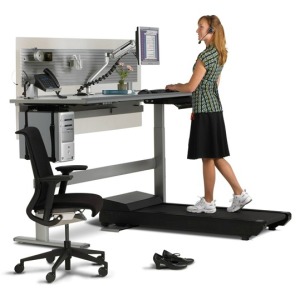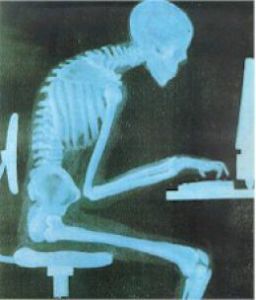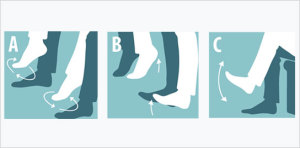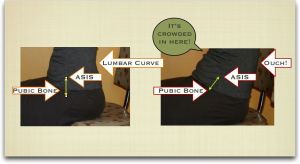Gentle Reader,
Sitting causes premature death. Wow, that’s a big statement. Imagine my surprise when an NRP report on the radio last week suggested that sitting will be the next “smoking” as a cause of early death. I have harped ad nauseum about the need to keep moving, but I didn’t think it would come to this.
“Sitting is more dangerous than smoking, kills more people than HIV and is more treacherous than parachuting. We are sitting ourselves to death.” Dr. James Levine, director of the Mayo Clinic-Arizona State University Obesity Solutions Initiative and inventor of the treadmill desk. Read more.

A study conducted as part of the Women’s Health Initiative titled Sedentary Behavior and Mortality in Older Women concluded that the women with the highest rate of sedentary life had a 95% increase in death by all causes than the women with the lowest rate of sitting. The study was conducted with over 92,000 women aged 50 – 79; body mass, age, ethnicity, physical function, physical activity and chronic disease were taken into consideration. They wanted to know if there is a correlation between a sedentary life style and diseases of cancer, cardiovascular and coronary heart disease. Sure enough, there is. What we all intuited is a sure thing: you lose it if you don’t use it. Keep moving!
In the radio report, the final word was “the next position is the best position,” i.e. move.
A similar study was conducted by Kaiser Permanente with over 85,000 men aged 45. The research covered 10 years of self-reporting for activity outside of work. Men with the lowest level of physical activity were more than twice as likely to develop heart failure than those in the most active group (7.8 heart failure cases per 1,000 person years compared with 3.8 cases). The men who spent the most time sitting were also more than twice as likely to develop heart failure than those who sat the least (8.8 heart failure cases per 1,000 person years compared with 3.8 cases).
For a lot of us this is bad news. We sit at our work, sometimes for hours at a stretch. I sit for hours in front of my computer. My “to-do” list everyday includes multiple tasks that require sitting at my desk. Many of us have office jobs where we are chained to our desks. Even work that requires moving around a fair amount includes several long stretches sitting at the computer.
In the study involving men, it didn’t matter what they did for work. Only their activity outside of work was considered. Apparently a man who moves all day at work but sits all evening and on the weekends, is not protected by his physical activity on the job. I find this “outside of work” fact to be particularly interesting. KUOW reported on this study in January of last year.
What happens to the body when we sit for long periods of time? The effects are scary.

- Muscle atrophy. Mushy abs; tight hips; limp gluts. You have to work your muscles to keep them.
- Organ damage. Heart, pancreas and colon begin to malfunction.
- Foggy brain. Slow circulation and a bent neck cause poor brain function.
- Soft bones and bad back. Joint health in general deteriorates when there is prolonged sitting. Avoiding osteoporosis requires weight bearing movement.
- Type II Diabetes risk increase It takes movement to get insulin into cells and control blood sugar
- Cancer risk increase Colon, endometrial and possibly lung cancers in particular
- Obesity increase even without an exercise program, simply moving more throughout the day keeps fat away
- Depression risk seven hours of sitting a day greatly increases depression
Benefits of moving are legion. My daughter Priscilla, personal trainer and group exercise specialist, is a strong proponent of the benefit of aerating your body. She believes that a half hour of vigorous exercise a day will flush the impurities from your blood and carry away bacteria, viruses and other unwanted invaders from your system. When your circulation slows down, blood pools, clots could form.

Sitting on an airplane is one of the worse things you can do to your circulation. For those of us who love to travel, the 9 – 12 hour flights can be deadly. For those who have to fly for work, here are some tips to keep moving in the air. Flex your calves. “Your calves are often called your second heart because of the role they play in helping pump venous blood from the lower extremities,” says Leslie Kaminoff, a yoga therapist and breathing specialist in New York. Something as simple as tapping the feet will also create movement in the shins and thighs, and even in the hip joint. Drink a lot of water because it will force you to get up and head for the lavatory.
I find that when I get up from a prolonged seated position, I have more pain and stiffness in my joints. I have noticed that if I can make myself take a short walk, the pain eases. In college I used to walk around the dorm reading, mostly to stay awake, but, I now realize, I needed to move then, too.
Working at home as many people do nowadays, you have to create a schedule for moving. I use a timer to remind me to get up. I might garden for 20 minutes; fold laundry; check on the chickens. The biggest problem with interrupting yourself as an at-home worker, is getting back to the desk. You could look at the clock and realize you’ve been in the garden for two hours. It requires vigilance and discipline to take a break, move, and get back to work.

Digestion issues from sitting too long, the pancreas and colon sluggishness, can be corrected so easily. Just a short walk will get things moving. I have a friend who takes a walk with her husband nearly every night after dinner. She’s the lovely person who introduced me to Shaklee and a whole new way of life back in 1985.
This article gives suggestions for moving: sit on a ball, walk around during commercials, get out of your chair and stretch the hip flexors every hour or so, get a standing work station (I found several references to using a treadmill desk) and do the cat/cow yoga exercise several times a day. Some of these are easier than others in an office setting.
Imagine what would happen if the Surgeon General of the US decreed that movement is a health necessity, not just a health benefit.
Sitting is often a relief, a relished pleasure when you are worn out from cooking, shopping, cleaning house, wrapping packages, wandering through an art gallery and you just can’t wait to sit down. I love that instant comfort that comes from collapsing into a chair or sofa. Fine. Enjoy. Just don’t let 4 – 5 hours go by in that sitting position before you get up and move again.
All the best for this holiday season. Get out and take a walk, snow shoe, ski, shoot baskets with your kids and  grandkids, dance. I’ve just started attending my oldest daughter, Grace and Jon, her husband’s Free Form Dance Dance on Saturday mornings. What a joy to move my body to great music for about 80 minutes in a big room with a wall of glass looking out into trees, and a group of people all joyously moving according to their inner guide!
grandkids, dance. I’ve just started attending my oldest daughter, Grace and Jon, her husband’s Free Form Dance Dance on Saturday mornings. What a joy to move my body to great music for about 80 minutes in a big room with a wall of glass looking out into trees, and a group of people all joyously moving according to their inner guide!
Want to have a long, engaged, active life?
Be Well, Do Well and Keeping moving.
Betsy
206 933 1889
www.HiHoHealth.com shopping for Shaklee
